|
|
|
|
|
Coastal Cruisin' The Dedicated Surfmobile |
|
I learned to drive in a cemetery from my stepmother. Whether she chose this particular network of quiet lanes due to the absence of traffic or because of all those graphic reminders of what awaits the unwary driver, I’ll never know. But except for the funeral cortège I disrupted when I stalled her car in front of the hearse, the lessons proceeded without a hitch and I won my spurs a few days after my sixteenth birthday. |
|
The reason I mention all this is because that driver’s license was my passport to surfing. Combined with a car, a part-time job and a fake ID for boozing and border crossings, it gave me the freedom to explore, and my world steadily broadened to include every inch of coastline from Point Conception to Punta Baja. The irony was that even though I lived only nine blocks from the Pacific Coast Highway in Santa Monica, I learned to drive before I learned to ride a surfboard. |
|
|
For despite its close proximity to Mother Ocean, Santa Monica is not a beach town in the same sense that Mission Beach, Seal Beach or Hermosa Beach are beach towns. |
California Incline - a painting by artist John
Comer |
|
|
|
|
|
Set high on the northern edge of the Pacific Palisades, with a steep drop into Santa Monica Canyon as the nearest escape route, it wasn’t really practical to grab a heavy board and walk or bicycle down to the beach from the neighborhood where I grew up. Not unless you were a lot less lazy than I was. So up until late fifties my experience of surfing was limited to rubber rafting, which I learned when I was eight or nine, and bodysurfing, which I picked up a couple of years later after watching a State Beach local use his body to plane across the wave’s surface before it broke. |
|
Mike Doyle and his Woody - a small portion of Marion Davies' |
|
|
Once I had my first surfboard ride, however, my fate was sealed. All I wanted from that moment on was a board of my own. And once I got it, my entire life revolved around an irresistible, insatiable need to ride waves. STOKA BOKA! |
|
|
The Dedicated Surfmobile
Like many drivers just turned 16, my first car turned out to be something my parents wanted me to drive - even if I was paying for it and wanted something else. Since I had to persuade two sets of parents who refused to converse with each other, I somehow ended up with an ultra safe‘n’solid all-American tank made of enough chrome and steel to build twenty of today’s Japanese compacts. To make matters worse, it was a metallic blue 1953 Buick convertible with leather seats, automatic top, electric windows, power steering, power brakes, wire wheels, white sidewalls and a ‘dynaflow’ transmission I’d aggressively thrust into low at every traffic light just to prove I wasn’t really a wimp. The Un-dedicated Surfmobile Today it would be worth a fortune. But back then it was merely a means of getting to more waves. So it didn’t take me long to totally ruin this gas guzzling behemoth and take possession of my first dedicated surfmobile (although some still think it was the other way around). |
|
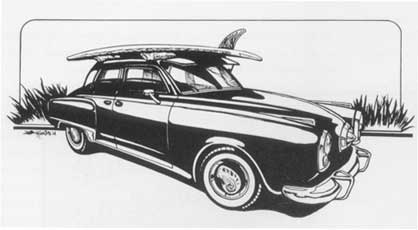 Drawing of my dedicated Studebaker by Kristina Biane for H20 Magazine, Vol.5, No.2 |
This sexy 1950 four door Studebaker sedan with automatic nothing cost me one hundred dollars flat. The elderly owner had bought it new and was only parting with it because he needed a car with all the features I’d just consigned to the junk heap. Bad timing. |
|
Just before he handed me the keys the man opened to trunk to show me two unopened cases of Pennzoil and a box containing every single service and repair record the car had ever had. “You look like a bright young fella, so listen up. See these boxes? Well, lube and oil her regular and don’t go using anything but this here Pennzoil,” he said and ran his hand tenderly along the flawless body and perfect paint. “She’s been good to me and she’ll be good to you if you just show her a little love and attention.” Backing down his drive, I glanced into the rear vision mirror and saw him wave a sad farewell as I drove his beautifully maintained automobile off into oblivion.
|
|
|
THE RACK Chucking a few boards into the Buick had been a snap. Just unzip the back window or lower the top, wedge the boards in the space between the seats and away you go. Now that I had a four door sedan, stowing the boards had suddenly become a problem. To my knowledge, there were no lockable surfboard racks in those days and the klunky looking racks that people did use could be easily removed and often were. I was also determined not to rip out the back seat and inhale carbon monoxide fumes every time I shoved the board through from the trunk. So I decided to design and build my own racks. |
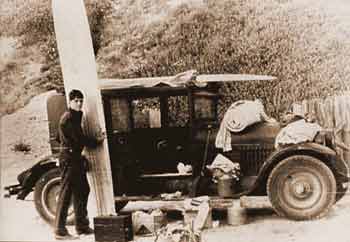
The really OLD 'good ole days' - 1925 Hudson |
|
A quick check around the ‘polio pond’ at Malibu revealed two perfect lengths of sandblasted driftwood (remember - these were the days before well meaning officials started removing dangerous objects like this from our public beaches to protect families with sun umbrellas). Borrowing an electric drill and some bits, I carefully positioned the first piece of driftwood on the roof and went for it. An hour later my new custom racks were fitted firmly to the top of the trusty Studebaker and my first ‘Coastal Cruiser’ was born. The racks were only the start, of course. Next followed the abalone shell hubcaps (to be replaced by coconut shells when they broke) and, until foul gases caused the putrefying squid I’d resined to the hood to explode outside of the Malibu Inn with such force that the Highway Patrolman sitting across the counter from me reached for his holster, the newly christened ‘CC Rider’ also featured a rather distinctive hood ornament.
|
|
|
|
In theory, my attempt to pay homage to the magnificent steer head that graced the hood of Leo Carrillo’s 1948 Chrysler Town & Country convertible. It might have worked, if I’d only been patient enough to let the squid dry out a bit. Then again, neither the crab or petrified star fish survived either, so I ended up settling for a fake ‘tiki’ with ruby red eyes. Toss in a couple of army surplus blankets, a can opener and a spoon and you could call it ‘home’. Eh Pancho! |
|
THE ROADS If the Pacific Coast Highway was the artery that connected the heart of 'North Bay' surfing to its disparate body, then Channel Road was its spine. I’d go through great lengths to be the first car to reach the lights at Seventh and San Vicente so I could take the roller coaster ride to the canyon floor and slalom along Channel to the lights which always waited for my arrival before turning red. Wait, wait, wait wait wait. Then up or down the coast, depending on the swell, the wind and the tide. |
|
|
Perhaps a few of you will remember that in the days before Pacific Avenue was brutally severed to provide an entrance for that excrementitious plastic playground known as Marina del Rey, you could drive from Point Mugu all the way down to San Pedro and never leave the coast. So a boy and his Cruiser had a lot of choice. Catch a hollow, bone crunching right or two at ‘Lighthouse’ before school and grab the evening glass off at State Beach or Malibu before heading down to Hermosa Beach for another South Bay party. Even when I worked on weekends and after school at Fireside Market on Montana, I could almost always squeeze in a surf. |
|
|
Since then, surfing spots like ‘Lighthouse’ (destroyed along with the lighthouse itself in the process of erecting the hideous box that houses the L.A. County Lifeguard headquarters), Hubbyland, Hendry’s, Dana Point and God knows where else have fallen victim to the bulldozer consciousness of soulless developers and pencil pushing bureaucrats. At the same time, the ‘heart’ of modern surfing has become so polluted that surfing Malibu’s sullied waters has become a ‘health risk’. And they call this ‘progress’!
|
|
|
No doubt Pennzoil is one of the best engine oils in the world and I’d been given 24 quarts to play with. But simply adding even the best oil from time to time is not enough. Like the man said, you actually need to change it on a regular basis and I was too busy driving up and down the coast to bother. So the Studebaker gave way to a series of other undeserving victims. And, all in all, I must have run a dozen cars into the ground before I finally learned what the old boy was trying to teach me when he said, "she’ll be good to you if you show her a little love and attention." |
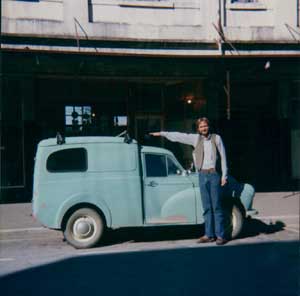 |
This time I bought some racks. |
|
Me and the
Morris van - Gisborne, New Zealand |
|
"Not a problem," said I. But money was a problem and after driving back to Kihei I quickly retrieved an empty dog food can from the rubbish, took out the bottom, cut it lengthwise and wrapped it around the offending pipe, using two old hose clips I pirated from somewhere else to tighten it down. |
|
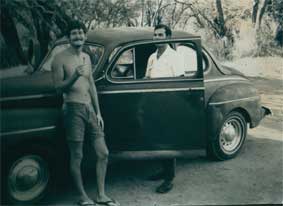 Da Boyz - Kihei, Maui circa 1969 - taken by Michael Georgiades
|
When I returned to the station, a local policeman had
taken the haole's place and cheerfully issued the sticker. As I turned
to go he sniffed the air and smiled. "Hummmm ..." he said
with genuine pleasure. "Sumpbody cookin’ sumpin’ gooood."
Walking slowly around the idling car, he stopped at the rear and gave
me a wink. "Da kine cornbif, meybe," he said, before sauntering
back into the station. Guess I should have washed the can. Coastal Cruisin' & The Dedicated Surfmobile ©Robert R. Feigel 2001, 2005 - All Rights Reserved |
|
|
|
|
Dedicated to the memory of Leo Carrillo’s 1948 Chrysler Town & Country convertible*, my step-mother's various Chevrolets, my mom and step-dad's various Packards, Tom McBride’s classic ’47 & ’51 Ford woodies, Jerry Whiteside’s modified Hopalong Cassidy surf-bike and homemade board-carrier with Flexi-flyer wheels, Stuart Lough's classic Cherry Woody*, Paul Fritz’s world famous 1918 Ford milk truck*, Darryl Kniss’ sleek'n'sexy gray primered '56 Oldsmobile coupe, Luman Bailey’s high-performance Anglia, Suzanne Murphy’s elegant soft-top Mercedes roadster, ‘Sticker’ Joe Moore’s four wheeled sticker collection, Dick Kutch’s grunty '51 Ford, Bill & Mary Cleary’s VW microbus camper with sunroof, Tiger Lil’s converted stepvan-cum-camper, Chuck Gates’ pristine Morris estate wagon, the pink Bedford bus minus driver’s door loaned to Rick & Toni Segoine by the Sacred Heart nuns on Maui, John & Linda Kiewit’s VW Westphalia campers, Roger Hanson’s Triumph 500 ... and every Volkswagen that has ever owned me.
|
|
|
* An instantly recognizable 'woody' convertible specially built for cowboy star Leo Carrillo - who played Poncho in the Cisco Kid movie and television series. Often seen cruising around Santa Monica in the fifties, it was painted the same color as Carrillo's Palomino pony. The car's most striking feature is the steer head mounted on the hood. In true Hollywood style, the eyes of the steer light up at night and the horn makes the sound of a bellowing bull. Part of an exhibition of classic Woodies that showed at the Petersen Automotive Museum in Los Angeles, Mr Carrillo used to park it in front of my parent's place in Santa Monica when he visited. Not a car you'd want to meet on a dark night after a few drinks. |
|
|
* Paul Fritz's magical milk truck on the Pacific Coast Highway- taken at Arroyo Sequit for a predictably imaginary Life Magazine article supposedly about "surfing," circa 1962 - after driving by the photographer several times, he asked us to do a Nazi salute to "make the shot more interesting." We stupidly obliged. Naturally, that was the photo Life Magazine used. Paul Fritz is driving, that's me stupidly obliging at shotgun and the other surf nazi at the rear is Duane King. Standing in the middle beside Carol Brown, hair flying in the wind, is Ed Vaughn, who helped organize the entire shoot for Life Magazine and went on to create, produce and direct the television program, SURF CITY (hosted by Dale Davis) for KTTV Channel 11 in Los Angeles. |
coastal cruisin' © Robert R. Feigel, 1998, 2002 - All rights reserved |
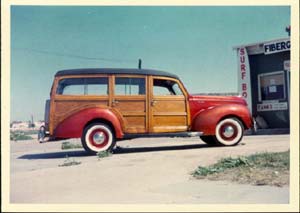 |
* Stuart Lough taught me how to surf at 'Little Dume' all those many years ago. He must have had incredible patience ... or a good sense of humor. Maybe both. Many thanks to you Stuart. |
|
| Stuart Lough's classic Cherry Woody in 1960. I think it's parked in front of the R & R Moselle surfboard shop. |
The same classic Woody in 2003. |
|
Coastal Cruisin' & The Dedicated Surfmobile ©Robert R. Feigel 2001, 2005 - All Rights Reserved |